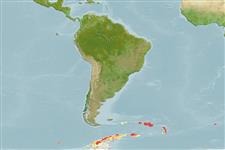Common names from other countries
Elasmobranchii (haaien en roggen) (sharks and rays) >
Rajiformes (Skates and rays) >
Rajidae (Skates)
Etymology: Amblyraja: Greek, amblys = darkness + Latin, raja, -ae = ray (Raja sp.) (Ref. 45335).
More on author: Norman.
Environment: milieu / climate zone / depth range / distribution range
Ecologie
marien bathydemersaal; diepte 20 - 350 m (Ref. 58839). Deep-water; 43°S - 74°S, 48°E - 23°W (Ref. 114953)
Southeast Pacific: Chile (Ref. 27540). Southern Ocean: around South Georgia Island and on the ridge westward towards Black Rocks. Occasionally seen on the Scotia Ridge.
Grootte / Gewicht / Leeftijd
Maturity: Lm ? range ? - ? cm
Max length : 115 cm TL mannelijk / geslacht onbekend; (Ref. 114953)
Found on continental and insular shelves, as well as upper slopes. Feeds mainly on small benthic invertebrates (Ref. 114953). Oviparous (Ref. 205). Reaches maturity at 80-90 cm TL; birth size at ca. 20 cm TL (Ref. 114953). Distinct pairing with embrace. Young may tend to follow large objects, such as their mother (Ref. 205). Eggs are oblong capsules with stiff pointed horns at the corners deposited in sandy or muddy flats (Ref. 205). Egg capsule measures 116.5 mm long and 80.0 mm wide (Ref. 41249). Utilized as fishmeal and possibly not utilized for human consumption due to extreme roughness of its squamation (Ref. 5159).
Levenscyclus en paargedrag
Maturities | Voortplanting | Spawnings | Egg(s) | Fecundities | Larven
Oviparous, paired eggs are laid. Embryos feed solely on yolk (Ref. 50449). Distinct pairing with embrace. Young may tend to follow large objects, such as their mother (Ref. 205). Eggs have horn-like projections on the shell (Ref. 205).
McEachran, J.D. and K.A. Dunn, 1998. Phylogenetic analysis of skates, a morphologically conservative clade of elasmobranchs (Chondrichthyes: Rajidae). Copeia 1998(2):271-290. (Ref. 27314)
Status op de Rode Lijst van het IUCN (Ref. 130435)
CITES (Ref. 128078)
Not Evaluated
Gevaar voor de mens
Harmless
Gebruik door de mens
Visserij: visserij voor eigen gebruik
Tools
Speciale rapporten
Download XML
Internetbronnen
Estimates based on models
Preferred temperature (Ref.
115969): -1.4 - 0.5, mean -0.6 (based on 28 cells).
Fylogenetische diversiteitsindex (Ref.
82804): PD
50 = 0.5010 [Uniqueness, from 0.5 = low to 2.0 = high].
Bayesian length-weight: a=0.00302 (0.00141 - 0.00645), b=3.24 (3.07 - 3.41), in cm Total Length, based on LWR estimates for this (Sub)family-body shape (Ref.
93245).
Trofisch niveau (Ref.
69278): 4.2 ±0.3 se; based on size and trophs of closest relatives
Weerstandsvermogen (Ref.
120179): laag, minimale populatieverdubbelingstijd 4,5-14 jaar (Assuming tm>5).
Fishing Vulnerability (Ref.
59153): High to very high vulnerability (69 of 100).
Climate Vulnerability (Ref.
125649): Moderate vulnerability (38 of 100).
